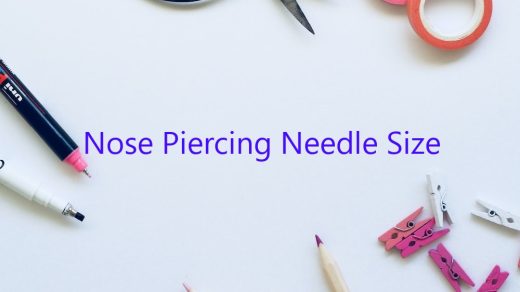What is a twin needle?
A twin needle is a type of sewing needle that has two points, as opposed to the usual one. This allows for two parallel lines of stitching to be sewn at the same time, which can be helpful for hemming or top-stitching fabrics. Twin needles come in a variety of sizes, but the most common are 80/12 and 90/14.
How do I use a twin needle?
To use a twin needle, first make sure that your machine is set to its “twin needle” setting. Then, thread the machine as usual, making sure that the two threads are coming out of the needle at the same time. Next, place the fabric you want to hem or top-stitch under the needle, making sure that the two threads are lined up in the middle of the fabric. Finally, press down on the pedal and sew slowly, making sure to keep the two threads in the middle of the fabric.
Contents
Can I use a twin needle on any sewing machine?
Yes, you can use a twin needle on any sewing machine.
A twin needle is a type of needle that has two needles attached to it. This type of needle is often used to sew two rows of stitches at the same time.
A twin needle can be used on any type of sewing machine. However, you will need to adjust the settings on your machine to ensure that the stitches are sewn evenly.
If you are not familiar with how to use a twin needle, be sure to consult your sewing machine’s instruction manual.
What stitch do you use with a twin needle?
When using a twin needle, there are a few different stitches you can use. The three most popular stitches are the zigzag stitch, the straight stitch, and the French seam.
The zigzag stitch is a popular choice for twin needles because it creates a strong stitch that is also stretchy. This stitch is perfect for fabrics that need to stretch, like knits.
The straight stitch is a good choice for fabrics that don’t need a lot of stretch, like denim. It produces a strong, durable stitch.
The French seam is a good choice for when you want a really neat and tidy seam. This stitch is strong and looks great on both sides of the fabric.
How does twin needle sewing work?
How does twin needle sewing work?
Twin needle sewing is a technique used to create a professional looking finish on fabric edges. It involves using two needles at the same time to sew a seam. The result is a neat and durable seam that can withstand a lot of wear and tear.
The twin needle sewing technique is used to attach two pieces of fabric together. It can also be used to create a decorative stitch along the edge of a piece of fabric. The twin needle sewers two parallel lines of stitching that are close together. This creates a strong seam that is less likely to unravel.
The twin needle sewing technique is a great way to finish the edges of a piece of fabric. It creates a neat and professional looking finish that can be used on a variety of fabrics. The twin needle stitch is also very durable and can withstand a lot of wear and tear.
How do you use a dual needle?
A dual needle is a sewing tool that has two needles attached to it. It is used to sew fabric together by making two parallel rows of stitches. To use a dual needle, you must first thread it. To do this, hold the dual needle in one hand and thread one of the needles with the other hand. Then, insert the threaded needle into the fabric and make your stitches.
How do you stop a twin needle from tunneling?
If you’re using a twin needle to sew two pieces of fabric together, it’s important to stop the needle from tunneling through the fabric. This can cause the fabric to pucker and look uneven. There are a few ways to stop the needle from tunneling, and each method will work a little differently depending on the fabrics you’re using and the type of twin needle you’re using.
The first way to stop the needle from tunneling is to use a water soluble stabilizer. This is a thin piece of fabric that you place between the fabrics you’re sewing together. The stabilizer will help to hold the fabric together and keep the needle from tunneling.
Another way to stop the needle from tunneling is to use a paper towel. Fold a paper towel in half and place it between the fabrics you’re sewing together. The paper towel will help to hold the fabric together and keep the needle from tunneling.
Finally, you can use pins to stop the needle from tunneling. Place pins along the edge of the fabric where the needle is going to go through. This will help to hold the fabric together and keep the needle from tunneling.
Can you Backstitch with a twin needle?
Backstitching is a sewing technique that is used to secure or reinforce the seams of a project. It is a strong stitch that helps to keep the fabric from unraveling. Backstitching can be done with a single needle, but it is much easier to do with a twin needle.
A twin needle is a special type of needle that has two points. When it is inserted into the fabric, the two points come together and form a stitch. This stitch is very strong and helps to reinforce the seams of a project.
Backstitching can be used to sew a seam together or to sew a seam closed. It can also be used to secure a hem.
To backstitch with a twin needle, first make sure that the fabric is properly aligned. Then, insert the twin needle into the fabric and sew a few stitches. Be sure to hold the fabric tight as you sew, so that the stitches are evenly spaced.
When you are finished, remove the twin needle from the fabric and tie off the threads.
How do you keep a twin needle from tunneling?
When using a twin needle, it is important to keep the fabric from tunneling. This is done by adjusting the stitch length and the tension of the fabric.
To adjust the stitch length, use the knob on the right side of the machine. Turn it towards you to lengthen the stitch and away from you to shorten the stitch. Experiment with different lengths to find the right one for your project.
To adjust the tension of the fabric, use the tension control dial on the front of the machine. Turn it clockwise to increase the tension and counterclockwise to decrease the tension. Again, experiment with different settings to find the one that works best for your fabric.




